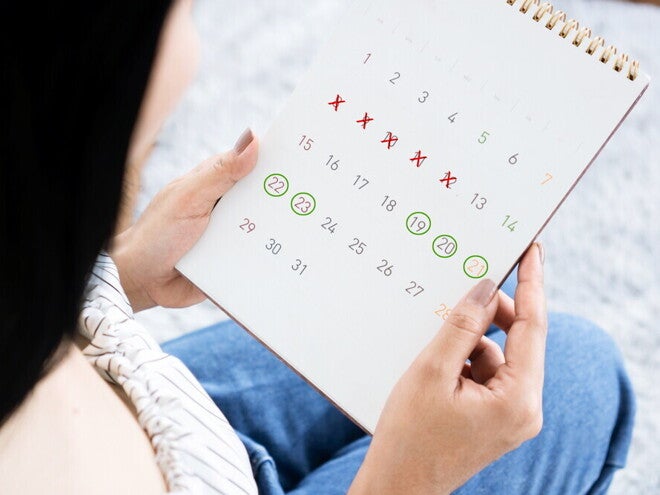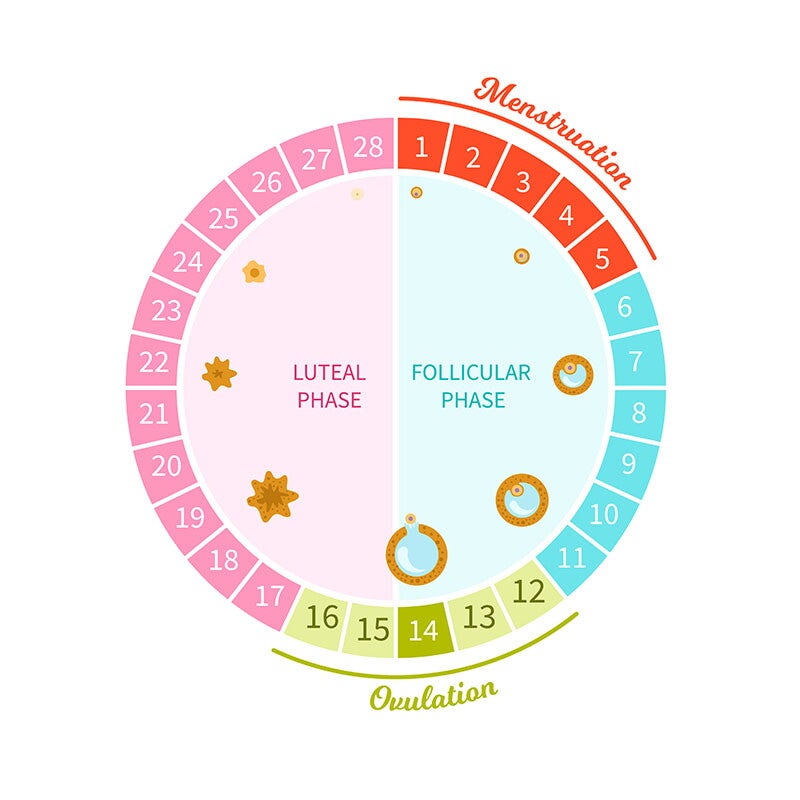
When Is Your Fertile Window? A Mom’s Guide to Natural Family Planning
Knowing your fertile window gives you the power to plan your family's future whether you're trying to conceive or planning to wait. And it all starts with learning to read the signs your body sends you each month.
What Is a Fertile Window and Why It Matters
Your fertile window is the specific time in your menstrual cycle when you're most likely to get pregnant. According to the American College of Obstetricians and Gynecologists (ACOG), this period includes the day of ovulation and the five days leading up to it, since the sperm can survive in your reproductive tract for up to five days.
This is why it is important to study the menstrual cycle. It helps you time intercourse to maximize your chances of conception or abstain from unprotected sex to avoid getting pregnant.
Understanding Your Menstrual Cycle

Your cycle has four main phases: the menstrual, follicular, ovulation, and luteal phases.
To pinpoint your fertile period, you first need to understand the 4 phases of the menstrual cycle:
The menstrual phase
While every woman's cycle is different, this phase typically lasts about five days in an average 28-day cycle. The first day of your period marks "Day 1" of your entire cycle.
The follicular phase
This phase also begins on Day 1 of your period but continues until ovulation. During this time, your body releases hormones that signal an egg to mature and prepare for its release. In an average cycle, this entire preparatory phase lasts approximately 13 days.
The ovulation phase
Ovulation is the release of a mature egg from the ovary. It happens about 14 days before your next period begins, though this can vary for each woman.
This is the shortest but most critical phase for getting pregnant. The egg can only be fertilized for about 12 to 24 hours after release, making this the peak of your fertility. To get a better idea of your most fertile days, try the ParenTeam Ovulation Calendar.
The luteal phase
The luteal phase begins right after ovulation and lasts until your next period starts, typically from day 15 to 28. This is when your body produces progesterone, a hormone that prepares the uterus for pregnancy.
If pregnancy doesn't occur, the uterine lining sheds and your period begins, starting the cycle all over again. If you did conceive, you’ll skip your period and may experience early signs of pregnancy. Consider taking a pregnancy test around 10 to 14 days after ovulation for the most accurate results.
Top 4 Methods to Track Your Fertile Period
Once you understand the phases of your cycle, you can begin tracking your fertile window. This is crucial for Fertility Awareness-Based Methods (FABMs), commonly known as natural family planning methods.
1. Calendar method
The calendar method for birth control works by tracking the length of your menstrual cycles for several months to find your fertile period.
To find your most likely fertile days, subtract 18 days from your shortest cycle and 11 days from your longest cycle. The time between those two dates is your estimated fertile window.
This method works best if your cycles are regular. Explore how to apply the calendar method to avoid or achieve pregnancy.
2. Cervical mucus method
Your body also provides clear clues about ovulation. The cervical mucus method involves observing changes in your vaginal discharge throughout your cycle.
As you approach ovulation, your estrogen levels rise, causing your cervical mucus to become clear, slippery, and stretchy, much like raw egg whites. This is your most fertile mucus, as it helps sperm travel to the egg.
Read more about the mucus method to learn how your discharge transitions from dry to sticky and then to a clear, stretchy consistency.
3. Basal body temperature (BBT) method
Your basal body temperature is your body's temperature at complete rest. Using a specialized thermometer, you take your temperature at the same time every morning before getting out of bed.
After ovulation, the hormone progesterone causes a slight but sustained increase in your BBT (about 0.5°F or 0.3°C). This temperature spike confirms that ovulation has occurred. Tracking it over time helps you predict when ovulation is likely to occur in future cycles.
4. Symptothermal method
For the most accurate results, you can combine the above techniques, known as the symptothermal method. You use cervical mucus to identify the start of your fertile window and your temperature rises to confirm when it has ended.
A 2022 review of modern FABMs confirmed this combined method is highly effective. However, the study notes that for the best success, you should learn from a certified educator.
Natural Family Planning: Pros and Cons

Discussing family planning with your partner is key to ensuring you are both aligned on your goals and the methods you choose.
The most significant benefit of natural family planning is it's hormone-free, affordable, and empowering. A 2023 review in the journal Gynecological Endocrinology found that using these methods gives women more control and awareness of their bodies and cycles.
However, the same study also points out that natural methods require proper training to be effective and can be less reliable if your cycles are irregular. According to the World Health Organization, this method also has a lower effectiveness rate than IUDs or hormonal contraceptives (typical use) and, importantly, doesn't protect against STIs.
Common Misconceptions About Fertility Tracking
Separate the myths from the facts to get the most out of fertility tracking.
You can only get pregnant on the day you ovulate
The truth is your fertile window lasts for about six days, not just one. While your egg only survives for about 24 hours after ovulation, sperm can survive inside your body for up to five days. Therefore, your fertile window is the total of those five days plus the day of ovulation (5 + 1 = 6 days). Having intercourse on any of these six days can lead to pregnancy.
A standard cycle is always 28 days long
While 28 days is the average cycle length, few women experience a 28-day cycle every single time. Cycles varying from 21 to 35 days are considered typical for adults. This is why it's better to note down the days when your period starts each month for a more accurate cycle length.
Natural family planning is the same as the rhythm method
The old rhythm method was a calendar calculation that's often inaccurate. Modern fertility awareness-based methods, like the symptothermal method, are far more sophisticated and effective because they rely on your unique, real-time biological signs.
Tracking Apps You Can Use
For a quick and simple estimate of your most fertile days, start with the ParenTeam Ovulation Calendar.
For more detailed daily logging of signs like your temperature and cervical mucus, you can also use your phone’s built-in health features or other dedicated apps, like Flo, Clue, Ovia, and Fertility Friend.
Frequently Asked Questions (FAQs)
Can I get pregnant right after my period?
It's unlikely but possible, especially if you have a short menstrual cycle. If you ovulate early, the sperm from intercourse right after your period could still be viable.
Can I use FABMs if my cycle is irregular?
Tracking can be more challenging, but it isn't impossible. Focusing on your daily fertility signs, like cervical mucus and BBT, will be much more reliable for you than the calendar method alone.
Can I use natural family planning while breastfeeding?
Yes, but it requires three specific conditions to work. For the first six months, you can rely on the Lactational Amenorrhea Method (LAM) if:
- You're breastfeeding exclusively
- Your period has not returned
- Your baby is less than six months old
Once your period returns or any of these conditions change, you must rely on other signs, like cervical mucus, as ovulation can occur before your first postpartum period.
Your Cycle, Your Health
Tracking your fertile window is also a powerful way to monitor your overall health. According to a 2022 review in Frontiers in Medicine, the information from tracking your cycle is valuable medical data that can help your doctor spot potential health issues.
By learning to identify your fertile window, you can plan or prevent pregnancy naturally. Understanding your body’s rhythm puts you in control of your fertility and health.
Join the ParentTeam Moms and Dads Facebook group and start a discussion on the importance of the fertile window in natural family planning.
References
Cleveland Clinic. "Ovulation." Accessed June 13, 2025. https://my.clevelandclinic.org/health/articles/23439-ovulation.
Department of Health, Philippines. The Philippine Family Planning Handbook, 2023 Edition. Manila: World Health Organization Philippines, 2024. Accessed June 13, 2025. https://cdn.who.int/media/docs/default-source/wpro---documents/countries/philippines/reports/phfphandbook-compressed.pdf?sfvrsn=1b2e1b63_1.
Johns Hopkins Medicine. "Calculating Your Monthly Fertility Window." Accessed June 13, 2025. https://www.hopkinsmedicine.org/health/wellness-and-prevention/calculating-your-monthly-fertility-window.
Martinez, LaQuita. "Pregnancy - identifying fertile days." MedlinePlus. Last reviewed March 31, 2024. Accessed June 13, 2025. https://medlineplus.gov/ency/article/007015.htm.
Monis, Caila N., and Mananbhai Tetrokalashvili. "Proliferative and Follicular Phases of the Menstrual Cycle." In StatPearls. Treasure Island, FL: StatPearls Publishing, 2025. Last updated September 12, 2022. Accessed June 13, 2025. https://www.ncbi.nlm.nih.gov/books/NBK542229/.
Natural Womanhood. "FAM Basics: The Rhythm Method." September 24, 2021. Last updated July 20, 2024. Accessed June 13, 2025. https://naturalwomanhood.org/fam-basics-what-is-the-rhythm-method-natural-birth-control/.
Peters, Azabelle, and Heba Mahdy. "Symptothermal Contraception." In StatPearls. Treasure Island, FL: StatPearls Publishing, 2025. Last updated November 13, 2023. Accessed June 13, 2025. https://www.ncbi.nlm.nih.gov/books/NBK564316/.
Thiyagarajan, D. K., H. Basit, and R. Jeanmonod. "Physiology, Menstrual Cycle." In StatPearls. Treasure Island, FL: StatPearls Publishing, 2025. Last updated September 27, 2024. Accessed June 13, 2025. https://www.ncbi.nlm.nih.gov/books/NBK500020/.
World Health Organization (WHO). "Family planning/contraception methods." September 5, 2023. Accessed June 13, 2025. https://www.who.int/news-room/fact-sheets/detail/family-planning-contraception.
Your Fertility. "Right time for sex." Accessed June 13, 2025. https://www.yourfertility.org.au/everyone/timing.














